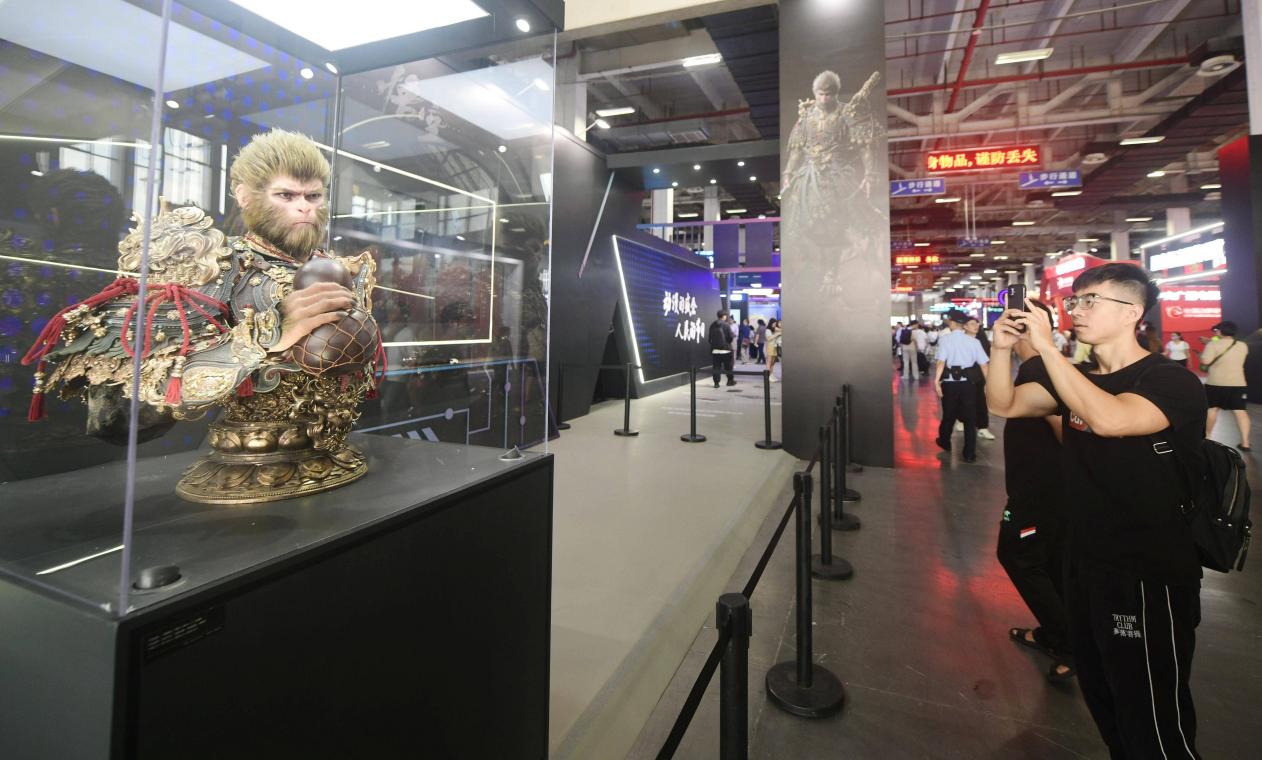




- BRNN
- BRI News
- BRNN News
- Database
Official Documents Polices and Regulations
Inter-government Documents International Cooperation BRI Countries
Business Guide Economic Data BRI Data
Trade
Investment Projects Latest projects
Cases - Content Pool

Tourists attend a digital art exhibition at the Zhejiang Museum in Hangzhou, east China's Zhejiang province. (Photo/Long Wei)
In recent months, the M511 complex, or M511 Light and Shadow Hui Commercial Center in Hangzhou, east China's Zhejiang province, drew a number of visitors from across the country.
Located on Hangzhou's Xixi Road, this M-shaped building leverages cutting-edge light and shadow technology to create a "micro park" of immersive audiovisual experiences.
The complex is home to a number of immersive installations built with 8K projection, triple-fold LED screens, and visual reality (VR) technology. Entering feels like stepping through a portal; visitors can traverse a field of stars or interact with renowned artworks, fully immersed in the fusion of light and art.
This exemplifies the growing intertwining of technology and culture, leading to increasingly diverse cultural experiences and consumer offerings. Such novel, technology-driven attractions are transforming public spaces into accessible "science and art museums," broadening both cultural participation and the boundaries of cultural consumption.
Developing the cultural industry requires robust policy support. Take Hangzhou's Xihu district as an example. Over the past three years, the district has invested more than 50 million yuan ($7.02 million) in cultural and creative projects, building a full-cycle support system that includes startup funding, loan interest subsidies, and direct investment funds. Tailored policies have also been introduced to encourage cultural enterprises to apply digital technologies, with one-time subsidies amounting to 5 percent of actual project investment - up to 500,000 yuan per enterprise each year.

A model of Wukong in the Chinese AAA video game Black Myth: Wukong is exhibited at the 21st China International Cartoon and Animation Festival held in Hangzhou, east China's Zhejiang province, May 29, 2025. (Photo/Long Wei)
The results speak volumes: in the first quarter of this year alone, Xihu district's cultural industry generated revenue of 10.16 billion yuan. This demonstrates the powerful multiplier effect targeted funding and precise policy incentives can have in fostering innovative cultural business models.
A thriving cultural industry also relies on strong platforms. The globally acclaimed Chinese-made AAA video game Black Myth: Wukong, the animated blockbuster Chang'an, which reignited the passion for Tang poetry, and Nobody, China's top-grossing 2D animated film - all trace their roots to Hangzhou's Artinno Town. Once a shuttered cement plant, the site has been transformed over the past decade through Hangzhou's efforts to build the Zhijiang and Grand Canal Cultural Belts. Today, it hosts more than 3,000 cultural and creative enterprises.
With platforms connecting industries and fostering clusters, businesses learn from each other, collaborate, and achieve shared success, accelerating the implementation of major cultural projects. With the government providing the foundational support and enterprises taking the lead, culture forms the spirit while industry serves as the chain. This synergy drives a virtuous cycle of cultural vitality and industrial prosperity.

Citizens visit a park transformed from the industrial remains of a steel mill in Hangzhou, east China's Zhejiang province, July 13, 2025. (Photo/Xu Genzhu)
A culturally thriving city is always appealing. An old grain depot and rice mill sites in Xihu district have been transformed into popular leisure destinations by adopting art and creative elements. In Xiaoshan district, a disused agricultural warehouse has been repurposed into an art park, which has welcomed over 20 million visitors and generated more than 600 million yuan in revenue since opening, becoming a cultural landmark and consumption hub. By infusing cultural creativity into urban renewal, Zhejiang continues to unlock the potential of culture, commerce, and tourism integration, generating powerful momentum for high-quality development.
Across Zhejiang, cultural landmarks - from the scenic West Lake and the ancient Liangzhu City to the picturesque water town of Wuzhen - continue to enhance their appeal. Meanwhile, innovative industries such as animation and gaming, artificial intelligence, and e-commerce are gaining global recognition.
Culture serves as both heritage and resource; technology offers support for and drives cultural development. By fostering economic prosperity through cultural vibrancy and advancing cultural renewal through technological innovation, Zhejiang is steadily moving toward the harmonious integration of material wealth and spiritual richness.

Tel:86-10-65363107, 86-10-65368220, 86-10-65363106